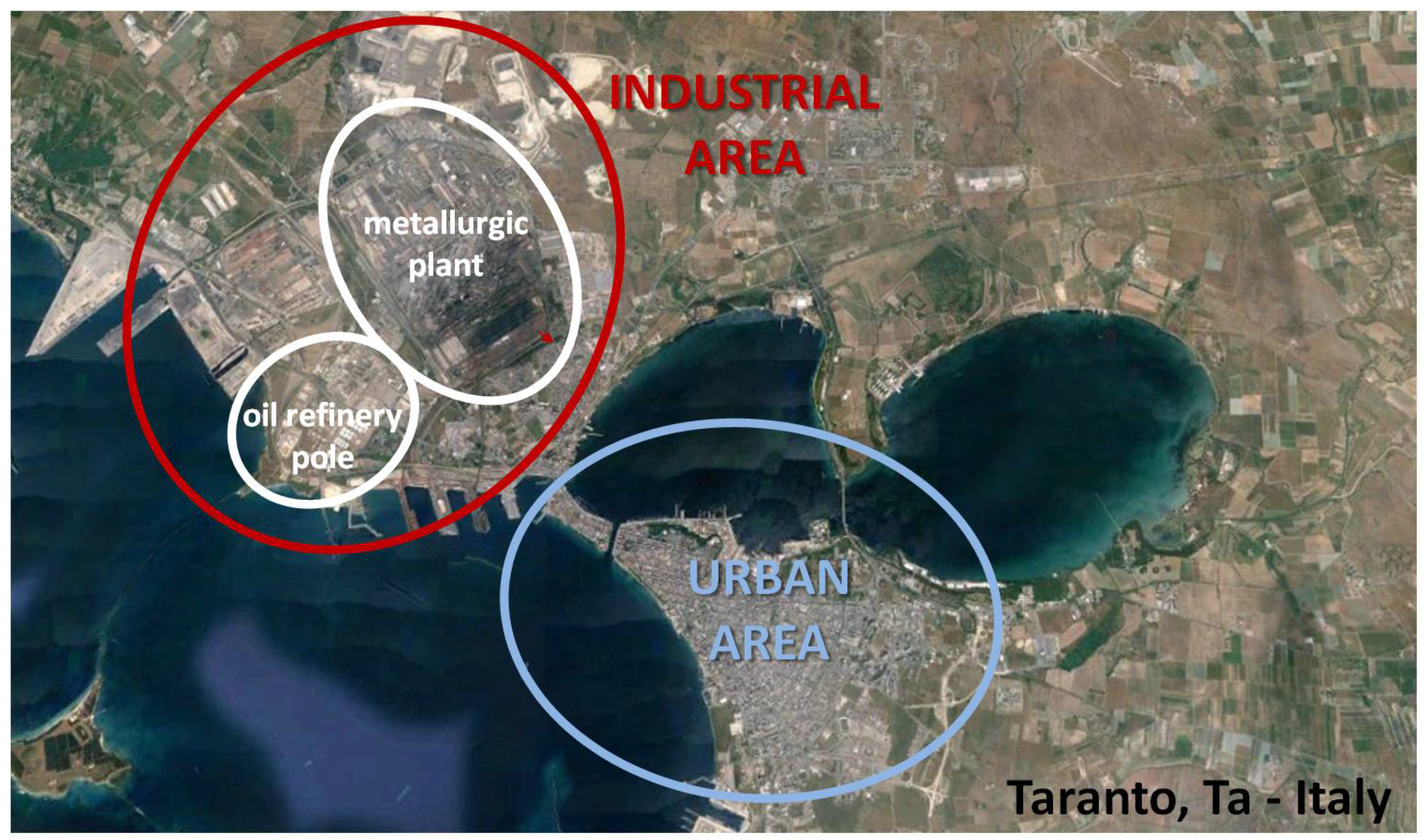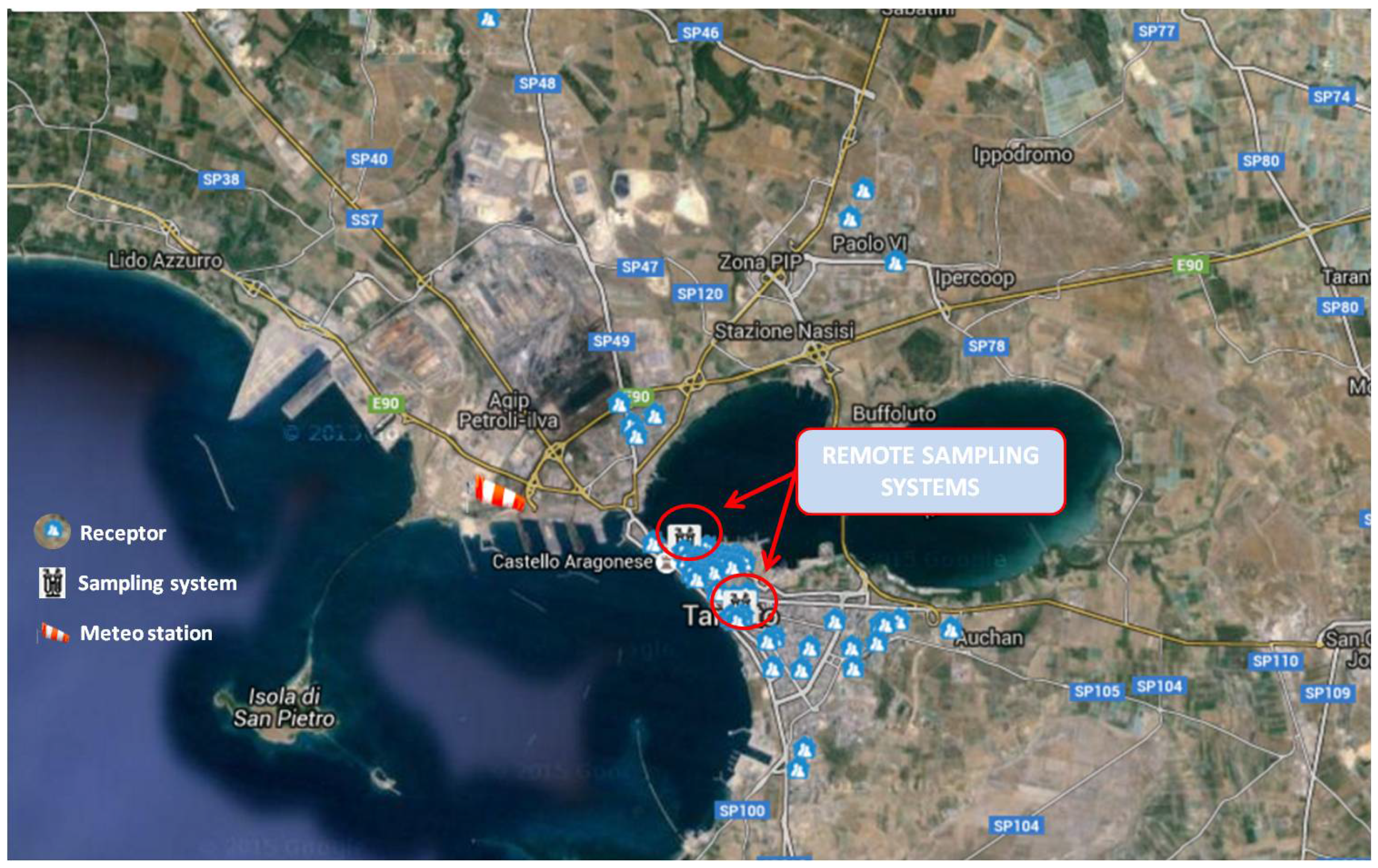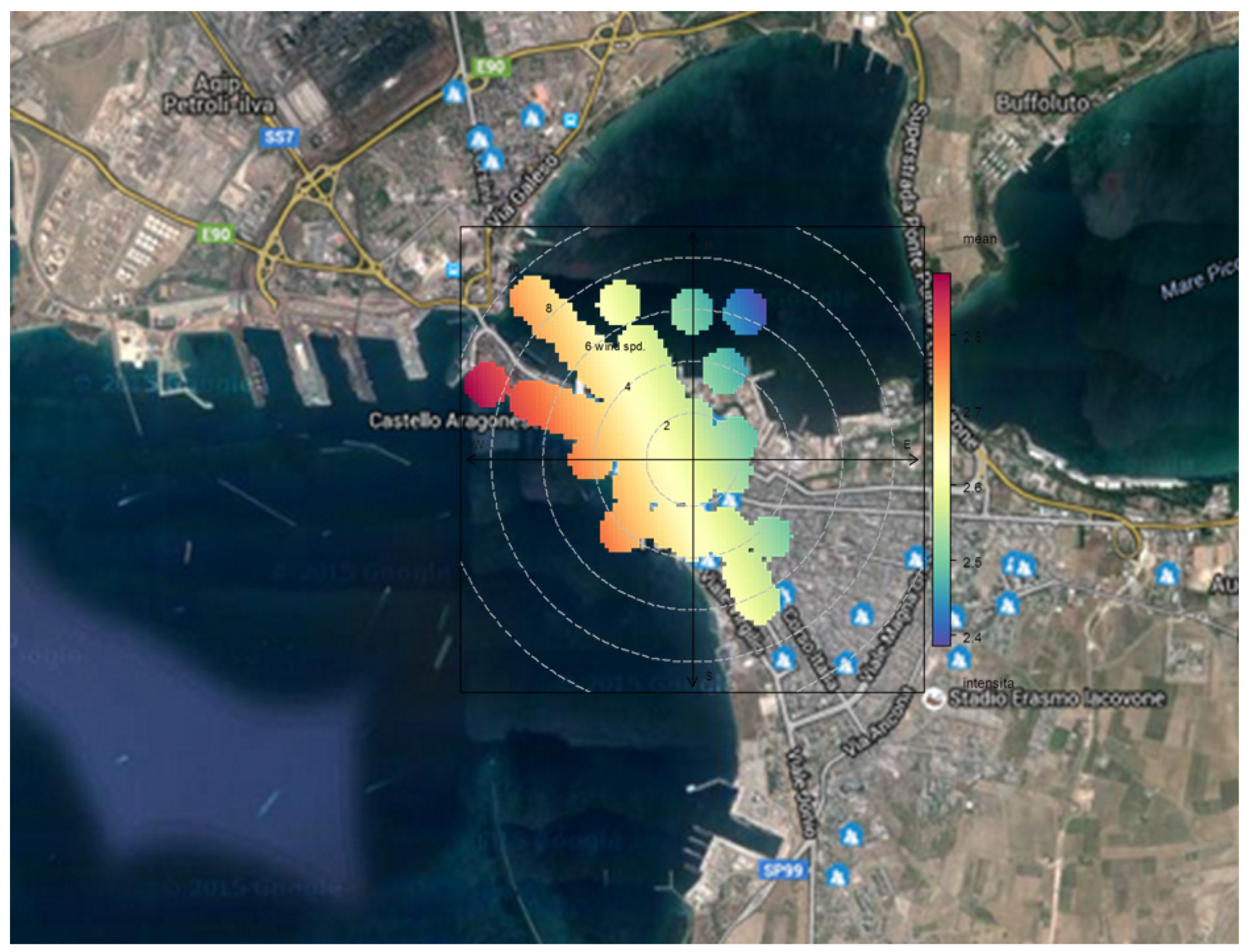Automated Collection of Real-Time Alerts of Citizens as a Useful Tool to Continuously Monitor Malodorous Emissions
Abstract
:1. Introduction
2. Experimental Section
2.1. Site Description
2.2. Integrated System Description
2.3. Steps of the Experimental Activities
2.3.1. Recruitment of the Sample Population
2.3.2. Remote Monitoring System
2.3.3. Sampling Protocol
2.4. Odor Analysis by Dynamic Olfactometry
3. Results and Discussion
3.1. Distribution of Citizen Complaints
Spatial Distribution
3.2. Evaluation of the Reliability of Citizen Complaints
3.3. Olfactometric Results
3.4. Integration of Air Quality Data with Odortel® System
4. Conclusions
Acknowledgments
Author Contributions
Conflicts of Interest
References
- Nicell, J.A. Assessment and regulation of odour impacts. Atmos. Environ. 2009, 43, 196–206. [Google Scholar] [CrossRef]
- Brattoli, M.; de Gennaro, G.; de Pinto, V. Odour Impact Monitoring for Landfills. In Integrated Waste Management; Kumar, S., Ed.; Intech: Rijeka, Croatia, 2011; Volume I, pp. 485–506. [Google Scholar]
- Brennan, B. Odour nuisance. Water Waste Treat. 1993, 36, 30–33. [Google Scholar]
- Schiffman, S.S. Livestock odors: Implications for human health and well-being. J. Anim. Sci. 1998, 76, 1343–1355. [Google Scholar] [PubMed]
- Stenlund, T.; Liden, E.; Andresson, K.; Garvill, J.; Nordin, S. Annoyance and health symptoms and their influencing factors: A population based air pollution intervention study. Public Health 2009, 123, 339–345. [Google Scholar] [CrossRef] [PubMed]
- Sucker, K.; Both, K.; Winneke, G. Review of adverse health effects of odours in field studies. Water Sci. Technol. 2009, 59, 1281–1289. [Google Scholar] [CrossRef] [PubMed]
- Yuwono, A.S.; Lammers, P.S. Odor Pollution in the environment and the detection instrumentation. Int. Agric. Eng. J. 2004, VI, 1–33. [Google Scholar]
- Shauberger, G.; Schmitzer, R.; Kamp, M.; Sowa, A.; Koch, R.; Eckhof, W.; Eichler, F.; Grimm, E.; Kypke, J.; Hartung, E. Empirical model derived from dispersion calculations to determine separation distances between livestock buildings and residential areas to avoid odour nuisance. Atmos. Environ. 2012, 46, 508–515. [Google Scholar] [CrossRef]
- Brattoli, M.; de Gennaro, G.; de Pinto, V.; Demarinis Loiotile, A.; Lovascio, S.; Penza, M. Odour detection methods: Olfactometry and chemical sensors. Sensors 2011, 11, 5290–5322. [Google Scholar] [CrossRef] [PubMed]
- Henshaw, P.; Nicell, J.; Sikdar, A. Parameters for the assessment of odour impacts on communities. Atmos. Environ. 2006, 40, 1016–1029. [Google Scholar] [CrossRef]
- Griffiths, K.D. Disentangling the frequency and intensity dimensions of nuisance odour, and implications for jurisdictional odour impact criteria. Atmos. Environ. 2014, 90, 125–132. [Google Scholar] [CrossRef]
- VDI 3940 Part1. Measurement of Odor Impact by Field Inspection—Measurement of the Impact Frequency of Recognizable Odors—Grid Measurement. Dusseldorf, Germany, 2006. Available online: https://www.beuth.de/en/technical-rule/vdi-3940-blatt-1/83789579 (accessed on 20 October 2015).
- Benzo, M.; Pittarello, A.; Giacerti, W.; Gandini, C.; Caccialanza, G. Full application of odour field inspection according to VDI 3940 in Italy: Odour impact evaluation of an anaerobic digestion plant. Chem. Eng. Trans. 2010, 23, 219–224. [Google Scholar]
- Guillot, J.M.; Bilsen, I.; Both, R.; Hangartner, M.; Kost, W.J.; Kunz, W.; Nicolas, J.; Oxbol, A.; Secanella, J.; van Belois, H.; et al. The future European standard to determine odour in ambient air by using field inspection. Water Sci. Technol. 2012, 66, 1691–1698. [Google Scholar] [CrossRef] [PubMed]
- Ranzato, L.; Barausse, A.; Mantovani, A.; Pittarello, A.; Benzo, M.; Palmeri, L. A comparison of methods for the assessment of odor impacts on air quality: Field inspection (VDI 3940) and the air dispersion model CALPUFF. Atmos. Environ. 2012, 61, 570–579. [Google Scholar] [CrossRef]
- Dentoni, L.; Capelli, L.; Sironi, S.; Guillot, J.M.; Rossi, A.N. Comparison of different approaches for odour impact assessment: Dispersion modelling (CALPUFF) vs. field inspection (CEN/TC 264). Water Sci. Technol. 2013, 68, 1731–1738. [Google Scholar] [CrossRef] [PubMed]
- Luginaah, I.N.; Taylor, S.M.; Elliott, S.J.; Eyles, J.D. A longitudinal study of the health impacts of a petroleum refinery. Soc. Sci. Med. 2000, 50, 1155–1166. [Google Scholar] [CrossRef]
- Miedema, H.M.E.; Walpot, J.I.; Vos, H.; Steunenberg, C.F. Exposure-annoyance relationships for odour from industrial sources. Atmos. Environ. 2000, 34, 2927–2936. [Google Scholar] [CrossRef]
- Luginaah, I.N.; Taylor, S.M.; Elliott, S.J.; Eyles, J.D. Community reappraisal of the perceived health effects of a petroleum refinery. Soc. Sci. Med. 2002, 55, 47–61. [Google Scholar] [CrossRef]
- Sironi, S.; Capelli, L.; Centola, P.; Del Rosso, R.; Pierucci, S. Odour impact assessment by means of dynamic olfactometry, dispersion modelling and social participation. Atmos. Environ. 2010, 44, 354–360. [Google Scholar] [CrossRef]
- Aatamila, M.; Verkasalo, P.K.; Korhonen, M.J.; Suominen, A.L.; Hirvonen, M.R.; Viluksela, M.K.; Nevalainen, A. Odour annoyance and physical symptoms among residents living near waste treatment centres. Environ. Res. 2011, 111, 164–170. [Google Scholar] [CrossRef] [PubMed]
- Axelsson, G.; Stockfelt, L.; Andersson, E.; Gidlof-Gunnarsson, A.; Sallsten, G.; Barregard, L. Annoyance and worry in a petrochemical industrial area-prevalence, time trends and risk indicators. Int. J. Environ. Res. Public Health 2013, 10, 1418–1438. [Google Scholar] [CrossRef] [PubMed]
- De Feo, G.; De Gisi, S.; Williams, I.D. Public perception of odours and environmental pollution attributed to MSW treatment and disposal facilities: A case study. Waste Manag. 2013, 33, 974–987. [Google Scholar] [CrossRef] [PubMed]
- Brancher, M.; de Melo Lisboa, E. Odour impact assessment by community survey. Chem. Eng. Trans. 2014, 40, 139–144. [Google Scholar]
- Brattoli, M.; De Gennaro, G.; Carella, G.; De Gennaro, L.; Assennato, G.; Giua, R.; Angiuli, L.; Trizio, L. Integration of automatic remote systems for olfactory annoyance detection and evaluation in the city of Taranto. Chem. Eng. Trans. 2014, 40, 19–24. [Google Scholar]
- Committee for European Normalization (CEN). EN13725: Air Quality—Determination of Odour Concentration by Dynamic Olfactometry; Committee for European Normalization (CEN): Brussels, Belgium, 2003. [Google Scholar]
- Harreveld, T.V. Odor concentration decay and stability in gas sampling bags. Air Waste Manag. Assoc. 2003, 53, 51–60. [Google Scholar] [CrossRef]
- Bakhtari, A. Managing Odour sample degradation through on-site olfactometry and proper sample transportation and storage. Chem. Eng. Trans. 2014, 40, 163–168. [Google Scholar]
- Blunden, J. Measurement, Analysis, and Modeling of Hydrogen Sulfide Emissions from a Swine Facility in North Carolina. Ph.D. Thesis, 2006. Available online: http://repository.lib.ncsu.edu/ir/bitstream/1840.16/4022/1/etd.pdf (accessed on 20 October 2015). [Google Scholar]
- Liang, C.C.V. Reduced Sulphur Compounds in Ambient Air and in Emissions from Wastewater Clarifiers at a Kraft Pulp Mill, Degree of Master of Applied Science, 2008. Available online: https://tspace.library.utoronto.ca/bitstream/1807/10434/1/Liang_Chien_Chi_Victor_MASc_200803_thesis.pdf (accessed on 20 October 2015).
- Zarra, T.; Reiser, M.; Naddeo, V.; Belgiorno, V.; Kranert, M. A comparative and critical evaluation of sampling materials in measurement of odour concentration by dynamic olfactometery. Chem. Eng. Trans. 2012, 30, 307–312. [Google Scholar]
- Sironi, S.; Eusebio, L.; Capelli, L.; Boiardi, E.; Del Rosso, R. Odour sample diffusion through double Nalophan TM bags. Chem. Eng. Trans. 2014, 40, 169–174. [Google Scholar]





 .
.
 .
.

| Number of Complaints/Intensity Level | |||
|---|---|---|---|
| November 2013–December 2014 | 2015 (through October) | Total | |
| FAINT ODOR (LEVEL 1) | 68 | 54 | 122 |
| DISTINCT ODOR (LEVEL 2) | 251 | 120 | 371 |
| VERY STRONG ODOR (LEVEL 3) | 460 | 187 | 647 |
| TOTAL | 779 | 361 | 1140 |
| Odor Concentration (ouE/m3) | Frequency (Number of Events) | Percentage (%) |
|---|---|---|
| <11 | 32 | 34 |
| 11–20 | 40 | 42 |
| 21–30 | 10 | 11 |
| 31–40 | 5 | 5 |
| 41–50 | 4 | 4 |
| 51–60 | 0 | 0 |
| 61–70 | 2 | 2 |
| 71–80 | 0 | 0 |
| 81–90 | 2 | 2 |
© 2016 by the authors; licensee MDPI, Basel, Switzerland. This article is an open access article distributed under the terms and conditions of the Creative Commons by Attribution (CC-BY) license (http://creativecommons.org/licenses/by/4.0/).
Share and Cite
Brattoli, M.; Mazzone, A.; Giua, R.; Assennato, G.; De Gennaro, G. Automated Collection of Real-Time Alerts of Citizens as a Useful Tool to Continuously Monitor Malodorous Emissions. Int. J. Environ. Res. Public Health 2016, 13, 263. https://doi.org/10.3390/ijerph13030263
Brattoli M, Mazzone A, Giua R, Assennato G, De Gennaro G. Automated Collection of Real-Time Alerts of Citizens as a Useful Tool to Continuously Monitor Malodorous Emissions. International Journal of Environmental Research and Public Health. 2016; 13(3):263. https://doi.org/10.3390/ijerph13030263
Chicago/Turabian StyleBrattoli, Magda, Antonio Mazzone, Roberto Giua, Giorgio Assennato, and Gianluigi De Gennaro. 2016. "Automated Collection of Real-Time Alerts of Citizens as a Useful Tool to Continuously Monitor Malodorous Emissions" International Journal of Environmental Research and Public Health 13, no. 3: 263. https://doi.org/10.3390/ijerph13030263






